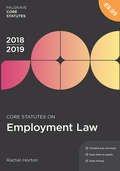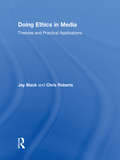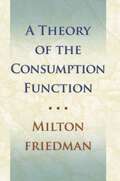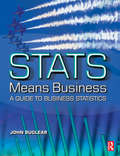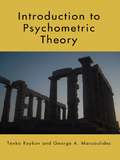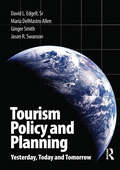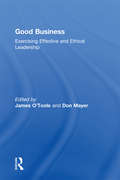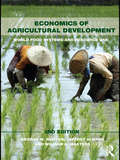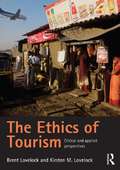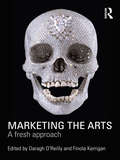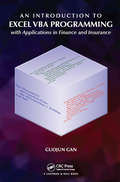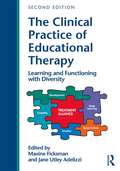- Table View
- List View
Core Statutes on Employment Law 2018-19 (Palgrave Core Statutes)
by Rachel HortonThe Palgrave Core Statutes series is designed to meet the needs of today's law students. Compiled by experienced lecturers, each title contains the essential materials needed at LLB level (and, where applicable, on GDL/CPE courses) and is easy to use under exam conditions and in the lecture hall.new_to_this_editionReplacement of the Data Protection Act with the General Data Protection RegulationThe Equality Act 2010 (Gender Pay Gap Information) Regulations 2017The Exclusivity Terms in Zero Hours Contracts (Redress) Regulations 2015
Emerging Markets Megatrends
by Rajiv BiswasThis book provides an assessment of the megatrends that are reshaping the emerging markets landscape. With developing countries already accounting for 40% of world GDP, emerging markets consumption growth will be an increasingly important growth engine for the world economy over the next two decades. However, emerging markets in many parts of Asia, Africa, the Middle East and Latin America are still facing tremendous economic challenges such as poverty, inequality, weak governance and inadequate infrastructure. The developed nations are no longer insulated from the economic shockwaves impacting developing countries, as globalisation and economic integration have also amplified the transmission effects to the West through immigration flows, cross-border crime and the proliferation of international terrorism.Emerging Markets Megatrends is an essential read for government policymakers, corporate executives, international investors and analysts wishing to understand more about the economic drivers and long-term outlook for emerging markets.
Emerging Markets Megatrends
by Rajiv BiswasThis book provides an assessment of the megatrends that are reshaping the emerging markets landscape. With developing countries already accounting for 40% of world GDP, emerging markets consumption growth will be an increasingly important growth engine for the world economy over the next two decades. However, emerging markets in many parts of Asia, Africa, the Middle East and Latin America are still facing tremendous economic challenges such as poverty, inequality, weak governance and inadequate infrastructure. The developed nations are no longer insulated from the economic shockwaves impacting developing countries, as globalisation and economic integration have also amplified the transmission effects to the West through immigration flows, cross-border crime and the proliferation of international terrorism.Emerging Markets Megatrends is an essential read for government policymakers, corporate executives, international investors and analysts wishing to understand more about the economic drivers and long-term outlook for emerging markets.
Doing Ethics in Media: Theories and Practical Applications
by Jay Black Chris RobertsDoing Ethics in Media: Theories and Practical Applications is an accessible, comprehensive introduction to media ethics. Its theoretical framework and grounded discussions engage students to think clearly and systematically about dilemmas in the rapidly changing media environment. The 13-chapter text is organized around six decision-making questions— the "5Ws and H" of media ethics. The questions encourage students to articulate the issues; apply codes, policies or laws; consider the needs of stakeholders; sift and sort through conflicting values; integrate philosophic principles; and pose a "test of publicity." Specifically, the questions ask: • What’s your problem? • Why not follow the rules? • Who wins, who loses? • What’s it worth? • Who’s whispering in your ear? • How’s your decision going to look? As they progress through the text, students are encouraged to resolve dozens of practical applications and increasingly complex case studies relating to journalism, new media, advertising, public relations, and entertainment. Other distinctive features include: • Comprehensive materials on classic moral theory and current issues such as truth telling and deception, values, persuasion and propaganda, privacy, diversity, and loyalty. • A user-friendly approach that challenges students to think for themselves rather than imposing answers on them. • Consistent connections between theories and the decision-making challenges posed in the practical applications and case studies. • A companion website with online resources for students, including additional readings and chapter overviews, as well as instructor materials with a test bank, instructor’s manual, sample syllabi and more. www.routledge.com/textbooks/black • A second website with continuously updated examples, case studies, and student writing – www.doingmediaethics.com. Doing Ethics in Media is aimed at undergraduates and graduate students studying media ethics in mass media, journalism, and media studies. It also serves students in rhetoric, popular culture, communication studies, and interdisciplinary social sciences.
Doing Ethics in Media: Theories and Practical Applications
by Jay Black Chris RobertsDoing Ethics in Media: Theories and Practical Applications is an accessible, comprehensive introduction to media ethics. Its theoretical framework and grounded discussions engage students to think clearly and systematically about dilemmas in the rapidly changing media environment. The 13-chapter text is organized around six decision-making questions— the "5Ws and H" of media ethics. The questions encourage students to articulate the issues; apply codes, policies or laws; consider the needs of stakeholders; sift and sort through conflicting values; integrate philosophic principles; and pose a "test of publicity." Specifically, the questions ask: • What’s your problem? • Why not follow the rules? • Who wins, who loses? • What’s it worth? • Who’s whispering in your ear? • How’s your decision going to look? As they progress through the text, students are encouraged to resolve dozens of practical applications and increasingly complex case studies relating to journalism, new media, advertising, public relations, and entertainment. Other distinctive features include: • Comprehensive materials on classic moral theory and current issues such as truth telling and deception, values, persuasion and propaganda, privacy, diversity, and loyalty. • A user-friendly approach that challenges students to think for themselves rather than imposing answers on them. • Consistent connections between theories and the decision-making challenges posed in the practical applications and case studies. • A companion website with online resources for students, including additional readings and chapter overviews, as well as instructor materials with a test bank, instructor’s manual, sample syllabi and more. www.routledge.com/textbooks/black • A second website with continuously updated examples, case studies, and student writing – www.doingmediaethics.com. Doing Ethics in Media is aimed at undergraduates and graduate students studying media ethics in mass media, journalism, and media studies. It also serves students in rhetoric, popular culture, communication studies, and interdisciplinary social sciences.
Theoretical Foundations of Corporate Finance (PDF)
by João Amaro de MatosCorporate finance is the area of finance that studies the determinants of firms' values, including capital structure, financing, and investment decisions. Although there are several excellent texts in corporate finance, this is the first to focus on the theoretical foundations of the subject in a consistent and integrated way at the Ph.D. level. In addition to a textbook for advanced graduate students, it can also serve as a general reference to researchers and sophisticated practitioners. The material presented is carefully selected with an eye to what is essential to understanding the underlying theory, ensuring that this text will remain useful for years to come. The book is divided into three parts. The first section presents the basic principles of valuation based on the absence of arbitrage, including a discussion of the determinants of the optimal capital structure based on the seminal results of Modigliani and Miller. The second section discusses the implications of agency problems and information asymmetries to capital structure, giving particular attention to payout policy and to debt contract design. The concluding portion presents different ways of restructuring capital, including going public, going private using stock repurchases or leveraged buyouts, and mergers and acquisitions. Each chapter includes exercises that vary in difficulty, with suggested solutions provided in an appendix. This book will assuredly be the standard doctoral- and professional-level explication of corporate finance theory and its appropriate applications.
Theory of the Consumption Function (PDF)
by Milton FriedmanWhat is the exact nature of the consumption function? Can this term be defined so that it will be consistent with empirical evidence and a valid instrument in the hands of future economic researchers and policy makers? In this volume a distinguished American economist presents a new theory of the consumption function, tests it against extensive statistical J material and suggests some of its significant implications. Central to the new theory is its sharp distinction between two concepts of income, measured income, or that which is recorded for a particular period, and permanent income, a longer-period concept in terms of which consumers decide how much to spend and how much to save. Milton Friedman suggests that the total amount spent on consumption is on the average the same fraction of permanent income, regardless of the size of permanent income. The magnitude of the fraction depends on variables such as interest rate, degree of uncertainty relating to occupation, ratio of wealth to income, family size, and so on. The hypothesis is shown to be consistent with budget studies and time series data, and some of its far-reaching implications are explored in the final chapter.
Stats Means Business (PDF)
by John Buglear'Stats Means Business' is an introductory textbook aimed at Business Studies students who require guidance in the area of statistics. It minimizes technical language, provides clear definition of key terms, and gives emphasis to interpretation rather than technique. 'Stats Means Business' enables readers to:* appreciate the importance of statistical analysis in business* understand statistical techniques* develop judgment in the selection of appropriate statistical techniques* interpret the results of statistical analysisThere is an overwhelming need for successful managers to be able to deal competently with numerical information and this text is developed with this in mind by providing worked examples and review questions which are rooted in viable business contexts.Each chapter includes guidance on using Excel and Minitab to produce the analysis described and explained in the chapter. The start of every chapter identifies aims and summarizes content and each is written in an accessible style. Model solutions are provided for three problems in each chapter and further solutions are available on a web site to accompany the book.The book is suitable for first year undergraduate courses, MBA Programmes and anyone who needs support and guidance in the area of statistics.
Introduction to Psychometric Theory
by Tenko Raykov George A. MarcoulidesThis new text provides a state-of the-art introduction to educational and psychological testing and measurement theory that reflects many intellectual developments of the past two decades. The book introduces psychometric theory using a latent variable modeling (LVM) framework and emphasizes interval estimation throughout, so as to better prepare readers for studying more advanced topics later in their careers. Featuring numerous examples, it presents an applied approach to conducting testing and measurement in the behavioral, social, and educational sciences. Readers will find numerous tips on how to use test theory in today’s actual testing situations. To reflect the growing use of statistical software in psychometrics, the authors introduce the use of Mplus after the first few chapters. IBM SPSS, SAS, and R are also featured in several chapters. Software codes and associated outputs are reviewed throughout to enhance comprehension. Essentially all of the data used in the book are available on the website. In addition instructors will find helpful PowerPoint lecture slides and questions and problems for each chapter. The authors rely on LVM when discussing fundamental concepts such as exploratory and confirmatory factor analysis, test theory, generalizability theory, reliability and validity, interval estimation, nonlinear factor analysis, generalized linear modeling, and item response theory. The varied applications make this book a valuable tool for those in the behavioral, social, educational, and biomedical disciplines, as well as in business, economics, and marketing. A brief introduction to R is also provided. Intended as a text for advanced undergraduate and/or graduate courses in psychometrics, testing and measurement, measurement theory, psychological testing, and/or educational and/or psychological measurement taught in departments of psychology, education, human development, epidemiology, business, and marketing, it will also appeal to researchers in these disciplines. Prerequisites include an introduction to statistics with exposure to regression analysis and ANOVA. Familiarity with SPSS, SAS, STATA, or R is also beneficial. As a whole, the book provides an invaluable introduction to measurement and test theory to those with limited or no familiarity with the mathematical and statistical procedures involved in measurement and testing.
Introduction to Psychometric Theory
by Tenko Raykov George A. MarcoulidesThis new text provides a state-of the-art introduction to educational and psychological testing and measurement theory that reflects many intellectual developments of the past two decades. The book introduces psychometric theory using a latent variable modeling (LVM) framework and emphasizes interval estimation throughout, so as to better prepare readers for studying more advanced topics later in their careers. Featuring numerous examples, it presents an applied approach to conducting testing and measurement in the behavioral, social, and educational sciences. Readers will find numerous tips on how to use test theory in today’s actual testing situations. To reflect the growing use of statistical software in psychometrics, the authors introduce the use of Mplus after the first few chapters. IBM SPSS, SAS, and R are also featured in several chapters. Software codes and associated outputs are reviewed throughout to enhance comprehension. Essentially all of the data used in the book are available on the website. In addition instructors will find helpful PowerPoint lecture slides and questions and problems for each chapter. The authors rely on LVM when discussing fundamental concepts such as exploratory and confirmatory factor analysis, test theory, generalizability theory, reliability and validity, interval estimation, nonlinear factor analysis, generalized linear modeling, and item response theory. The varied applications make this book a valuable tool for those in the behavioral, social, educational, and biomedical disciplines, as well as in business, economics, and marketing. A brief introduction to R is also provided. Intended as a text for advanced undergraduate and/or graduate courses in psychometrics, testing and measurement, measurement theory, psychological testing, and/or educational and/or psychological measurement taught in departments of psychology, education, human development, epidemiology, business, and marketing, it will also appeal to researchers in these disciplines. Prerequisites include an introduction to statistics with exposure to regression analysis and ANOVA. Familiarity with SPSS, SAS, STATA, or R is also beneficial. As a whole, the book provides an invaluable introduction to measurement and test theory to those with limited or no familiarity with the mathematical and statistical procedures involved in measurement and testing.
Tourism Policy and Planning (PDF)
by David L. Edgell Sr Maria Del Mastro AllenFor many communities and countries throughout the world tourism is the most valuable industry. Economic changes taking place in China, India, and the United States (with almost 3 billion people, half the world's population), for example, will have major impacts on the global tourism markets of tomorrow. Social-cultural changes in Europe, with borderless tourism crossings and a common currency, are increasing opportunities for tourism growth. East Asia and the Pacific Rim are experiencing unprecedented growth and change in tourism. From the perspective of economic policy, tourism for local communities is a vital economic development tool producing income, creating jobs, spawning new businesses, spurring economic development, promoting economic diversification, developing new products, and contributing to economic integration. If local and national governments are committed to broad based tourism policies, then tourism will provide its citizens with a higher quality of life while it generates sustained economic, environmental, and social benefits. The wellspring to future growth for tourism throughout the world is a commitment toward good policy. Governments, the private sector, and not-for-profit agencies must be the leaders in a sustainable tourism policy that transcends the economic benefits and embraces environmental and cultural interests as well. Tourism Policy and Planning: Yesterday, Today, and Tomorrow addresses key ingredients for positive tourism policies and planning that will lead this generation and the next toward a greater quality of life resulting from tourism growth. The aim of this book is to provide government policy-makers (at all levels), business leaders, not-for-profit executives, university professors, students, tourism industry managers, and the general public with an introduction and examination of important policy and planning issues in tourism.
Good Business: Exercising Effective and Ethical Leadership
by James O'Toole Don MayerThis illuminating and practical collection of essays addresses the increasingly important topics of corporate ethics, social responsibility, and sustainability in the context of effective global business strategies. Instead of condemning business, or exhorting corporate leaders to "do good," the authors deal with the "hot button" issues of our time in a cool and rational manner, seeing them as opportunities rather than as problems. As the authors illustrate, there is no necessary trade-off between business leaders doing the right thing, on one hand, and the profitable thing, on the other. They demonstrate that ethics is not peripheral, or in addition to, the central concerns of business. To the contrary, ethics and good citizenship are at the heart of all good business strategies, decisions, and organizational cultures. These essays offer useful examples of how executives can create strategies and cultures that are, both and at the same time, ethical and effective--the essence of GOOD BUSINESS. A PUBLICATION OF THE INSTITUTE FOR ENTERPRISE ETHICS Daniels College of Business, University of Denver
Good Business: Exercising Effective and Ethical Leadership
by James O'Toole Don MayerThis illuminating and practical collection of essays addresses the increasingly important topics of corporate ethics, social responsibility, and sustainability in the context of effective global business strategies. Instead of condemning business, or exhorting corporate leaders to "do good," the authors deal with the "hot button" issues of our time in a cool and rational manner, seeing them as opportunities rather than as problems. As the authors illustrate, there is no necessary trade-off between business leaders doing the right thing, on one hand, and the profitable thing, on the other. They demonstrate that ethics is not peripheral, or in addition to, the central concerns of business. To the contrary, ethics and good citizenship are at the heart of all good business strategies, decisions, and organizational cultures. These essays offer useful examples of how executives can create strategies and cultures that are, both and at the same time, ethical and effective--the essence of GOOD BUSINESS. A PUBLICATION OF THE INSTITUTE FOR ENTERPRISE ETHICS Daniels College of Business, University of Denver
Project Management Theory and Practice, Third Edition
by Gary L. Richardson Brad M. JacksonProject Management: Theory and Practice, Third Edition gives students a broad and real flavor of project management. Bringing project management to life, it avoids being too sterilely academic and too narrowly focused on a particular industry view. It takes a model-based approach towards project management commonly used in all industries. The textbook aligns with the latest version of the Project Management Institute’s Project Management Body of Knowledge (PMBOK®) Guide, which is considered to be the de facto standard for project management. However, it avoids that standard’s verbiage and presents students with readable and understandable explanations. Core chapters align with the Project Management Institute’s model as well as explain how this model fits real-world projects. The textbook can be used as companion to the standard technical model and help those studying for various project management certifications. The textbook takes an in-depth look at the following areas important to the standard model: Work Breakdown Structures (WBS) Earned Value Management (EVM) Enterprise project management Portfolio management (PPM) Professional responsibility and ethics Agile life cycle The text begins with a background section (Chapters 1–9) containing material outside of the standard model structure but necessary to prepare students for the 10 standard model knowledge areas covered in the chapters that follow. The text is rounded out by eight concluding chapters that explain advanced planning approaches models and projects’ external environments. Recognizing that project management is an evolving field, the textbook includes section written by industry experts who share their insight and expertise on cutting-edge topics. It prepares students for upcoming trends and changes in project management while providing an overview of the project management environment today. In addition to guiding students through current models and standards, Project Management: Theory and Practice, Third Edition prepares students for the future by stimulating their thinking beyond the accepted pragmatic view.
Information Technology Control and Audit, Fifth Edition
by Angel R. OteroThe new fifth edition of Information Technology Control and Audit has been significantly revised to include a comprehensive overview of the IT environment, including revolutionizing technologies, legislation, audit process, governance, strategy, and outsourcing, among others. This new edition also outlines common IT audit risks, procedures, and involvement associated with major IT audit areas. It further provides cases featuring practical IT audit scenarios, as well as sample documentation to design and perform actual IT audit work. Filled with up-to-date audit concepts, tools, techniques, and references for further reading, this revised edition promotes the mastery of concepts, as well as the effective implementation and assessment of IT controls by organizations and auditors.
Economics of Agricultural Development: 2nd Edition (Routledge Textbooks in Environmental and Agricultural Economics)
by George W. Norton Jeffrey Alwang William A. MastersThe globalization of goods, services and capital for agriculture is fundamental to the future of developing countries and has major implications for the fight against poverty and sustainability of the environment. In recent years, agriculture has once again returned to a position of centre stage as food price volatility has led countries to re-examine their development strategies. This new edition of the essential textbook in the field builds on the 2006 original and reflects the following developments: the increased impact of climate change issues affecting agricultural markets such as bio-fuels, the rise in farm prices and energy costs the move to higher valued agricultural products The book contains a wealth of real world case studies and is now accompanied by a website that includes powerpoint lectures, a photo bank and a large set of discussion and exam questions.The accompanying website is available to view at http://ecagdev.agecon.vt.edu/
Economics of Agricultural Development: 2nd Edition (Routledge Textbooks in Environmental and Agricultural Economics)
by George W. Norton Jeffrey Alwang William A. MastersThe globalization of goods, services and capital for agriculture is fundamental to the future of developing countries and has major implications for the fight against poverty and sustainability of the environment. In recent years, agriculture has once again returned to a position of centre stage as food price volatility has led countries to re-examine their development strategies. This new edition of the essential textbook in the field builds on the 2006 original and reflects the following developments: the increased impact of climate change issues affecting agricultural markets such as bio-fuels, the rise in farm prices and energy costs the move to higher valued agricultural products The book contains a wealth of real world case studies and is now accompanied by a website that includes powerpoint lectures, a photo bank and a large set of discussion and exam questions.The accompanying website is available to view at http://ecagdev.agecon.vt.edu/
The Ethics of Tourism: Critical and Applied Perspectives
by Brent Lovelock Kirsten LovelockThere are increasingly strident calls from many sectors of society for the tourism industry, the world’s largest industry, to adopt a more ethical approach to the way it does business. In particular there has been an emphasis placed on the need for a more ethical approach to the way the tourism industry interacts with consumers, the environment, with indigenous peoples, those in poverty, and those in destinations suffering human rights abuses. This book introduces students to the important topic of tourism ethics and illustrates how ethical principles and theory can be applied to address contemporary tourism industry issues. A critical role of the book is to highlight the ethical challenges in the tourism industry and to situate tourism ethics within wider contemporary discussions of ethics in general. Integrating theory and practice the book analyses a broad range of topical and relevant tourism ethical issues from the urgent ‘big-picture’ problems facing the industry as a whole (e.g. air travel and global warming) to more micro-scale everyday issues that may face individual tourism operators, or indeed, individual tourists. The book applies relevant ethical frameworks to each issue, addressing a range of ethical approaches to provide the reader with a firm grounding of applied ethics, from first principles. International case studies with reflective questions at the end are integrated throughout to provide readers with valuable insight into real world ethical dilemmas, encouraging critical analysis of tourism ethical issues as well as ethically determined decisions. Discussion questions and annotated further reading are included to aid further understanding. The Ethics of Tourism: Critical and Applied Perspectives is essential reading for all Tourism students globally.
The Ethics of Tourism: Critical and Applied Perspectives
by Brent Lovelock Kirsten LovelockThere are increasingly strident calls from many sectors of society for the tourism industry, the world’s largest industry, to adopt a more ethical approach to the way it does business. In particular there has been an emphasis placed on the need for a more ethical approach to the way the tourism industry interacts with consumers, the environment, with indigenous peoples, those in poverty, and those in destinations suffering human rights abuses. This book introduces students to the important topic of tourism ethics and illustrates how ethical principles and theory can be applied to address contemporary tourism industry issues. A critical role of the book is to highlight the ethical challenges in the tourism industry and to situate tourism ethics within wider contemporary discussions of ethics in general. Integrating theory and practice the book analyses a broad range of topical and relevant tourism ethical issues from the urgent ‘big-picture’ problems facing the industry as a whole (e.g. air travel and global warming) to more micro-scale everyday issues that may face individual tourism operators, or indeed, individual tourists. The book applies relevant ethical frameworks to each issue, addressing a range of ethical approaches to provide the reader with a firm grounding of applied ethics, from first principles. International case studies with reflective questions at the end are integrated throughout to provide readers with valuable insight into real world ethical dilemmas, encouraging critical analysis of tourism ethical issues as well as ethically determined decisions. Discussion questions and annotated further reading are included to aid further understanding. The Ethics of Tourism: Critical and Applied Perspectives is essential reading for all Tourism students globally.
Marketing the Arts: A Fresh Approach
by Daragh O'Reilly Finola KerriganIn recent years, there have been significant shifts in arts marketing, both as a practice and an academic discipline. The relationship between art and the market is increasingly complex and dynamic, requiring a transformation in the way the arts are marketed. Marketing the Arts argues that arts marketing is not about the simple application of mainstream managerial marketing to the arts. With contributions from international scholars of marketing and consumer studies, this book engages directly with a range of contemporary themes, including: The importance of arts consumption and its social dimensions The importance of the aesthetic experience itself, and how to research it Arts policy development The art versus commerce debate The role of the arts marketer as market-maker The artist as brand or entrepreneur This exciting new book covers topics as diverse as Damien Hirst’s 'For the Love of God', Liverpool’s brand makeover, Manga scanlation, Gob Squad, Surrealism, Bluegrass music, Miles Davis and Andy Warhol, and is sure to enthuse students and enlighten practitioners.
Marketing the Arts: A Fresh Approach
by Daragh O'Reilly Finola KerriganIn recent years, there have been significant shifts in arts marketing, both as a practice and an academic discipline. The relationship between art and the market is increasingly complex and dynamic, requiring a transformation in the way the arts are marketed. Marketing the Arts argues that arts marketing is not about the simple application of mainstream managerial marketing to the arts. With contributions from international scholars of marketing and consumer studies, this book engages directly with a range of contemporary themes, including: The importance of arts consumption and its social dimensions The importance of the aesthetic experience itself, and how to research it Arts policy development The art versus commerce debate The role of the arts marketer as market-maker The artist as brand or entrepreneur This exciting new book covers topics as diverse as Damien Hirst’s 'For the Love of God', Liverpool’s brand makeover, Manga scanlation, Gob Squad, Surrealism, Bluegrass music, Miles Davis and Andy Warhol, and is sure to enthuse students and enlighten practitioners.
An Introduction to Excel VBA Programming: with Applications in Finance and Insurance
by Guojun GanExcel Visual Basic for Applications (VBA) can be used to automate operations in Excel and is one of the most frequently used software programs for manipulating data and building models in banks and insurance companies. An Introduction to Excel VBA Programming: with Applications in Finance and Insurance introduces readers to the basic fundamentals of VBA Programming while demonstrating applications of VBA to solve real-world problems in finance and insurance. Assuming no prior programming experience and with reproducible examples using code and data, this text is suitable for advanced undergraduate students, graduate students, actuaries, and financial analysts who wish to learn VBA. Features: Presents the theory behind the algorithms in detail Includes more than 100 exercises with selected solutions Provides VBA code in Excel files and data to reproduce the results in the book Offers a solutions manual for qualified instructors
The Clinical Practice of Educational Therapy: Learning and Functioning with Diversity
by Maxine Ficksman Jane Utley AdelizziDespite the wide array of services offered to students with learning disabilities, attention-deficit disorder, and a variety of comorbid conditions, large numbers of students are caught in the struggle of surviving school. Unfortunate school experiences may impact their sense of self and the degree of tenacity with which they pursue further training or challenging opportunities in the workplace. These are the people for whom educational therapy provides relief, enlightenment, and the coveted prize of success. The second edition of The Clinical Practice of Educational Therapy, the first textbook in its field, provides a comprehensive perspective of this interdisciplinary profession and practice, reaching out to a more global audience. The book describes the scope and practice of educational therapy from its European roots to its growing presence in the United States, providing readers with case studies and research that illustrate the work of educational therapists across the lifespan in diverse settings. Interdisciplinary Perspective — Other books focus on either educational or therapeutic interventions but rarely discuss the blend and synergy of disciplines (e.g., special education, neuropsychology, assessment, and social work) that are the hallmark of this unique profession. Illustrative Cases — The text draws heavily on case studies as a means of understanding the practice of educational therapy, especially the dynamic relationship that exists between therapist and client. Numerous charts and tables provide visuals for educational therapists as well as allied professionals, parents, and those with learning challenges. Expertise — The editors are both highly visible educational therapists. Chapter authors are either experienced educational therapists or allied professionals who have made scholarly contributions to the profession, such as Trisha Waters, Roslyn Arnold, and George McCloskey. In addition to benefiting educational therapists and students, this book is appropriate for professionals who work in related fields such as special education, regular education, school and educational psychology, neuropsychology, school counseling, psychology, speech and language pathology, art therapy, occupational therapy, and social work, as well as in medicine and psychiatry. NEW TO THE SECOND EDITION The second edition of The Clinical Practice of Educational Therapy: Learning & Functioning with Diversity has revised and updated the chapters from the first edition, and added three new chapters which further define and broaden this field by exploring diverse perspectives: Chapter 10, "Cultivating Character Development: Educational Therapy’s Impact on Individuals, Families, Schools, Educational Policy, and Society" by Maxine Ficksman Chapter 12, "Women and Girls Who Are Disenfranchised: A Global and Interdisciplinary Approach to Educational Therapy" by Jane Utley Adelizzi Chapter 17, "Examining the Efficacy of Graduate Programs in Educational Therapy at California State University, Northridge (CSUN): Educational Therapy Intern, Graduate and Parent Perspectives" by Marcy Dann, Nancy Burstein, Tamarah Ashton, and Sue Sears. These additional chapters, supported by brain-based research, characterize the shifts and changes experienced in a range of settings. Through the treatment alliance, educational therapists address students’ and clients’ ability to experience a more comprehensive model of learning, dependent upon the psychological, social, emotional, cultural and academic environments. The three new chapters range in focus from formal research and graduate training in the field of educational therapy to students throughout the lifespan whose social and educational experiences require a careful eye to not only the academic task at hand but also to the ways in which they cope and adapt to a range of environments and challenges. Lastly, educational therapy’s empathic foundation in practice is exemplified when we consider the global experience of students who strive to learn in situations and settings that threaten their survival a
Introduction to Air Transport Economics: From Theory to Applications
by Ken Fleming Bijan Vasigh Thomas TackerIntroduction to Air Transport Economics: From Theory to Applications uniquely merges the institutional and technical aspects of the aviation industry with their theoretical economic underpinnings. Its integrative approach offers a fresh point of view that will find favor with many students of aviation. This third edition has been extensively updated throughout. It features new material that stresses the dynamic aspects of demand and supply and the ongoing competitive aspects of the marketplace. It now features an introductory chapter, and specific examples, to more directly relate management decisions to the economic theory. Also, in addition to an expanded coverage of revenue management and pricing decisions, the third edition includes case studies that give real-world examples to reflect actual industry practice as well as a discussion of the more up-to-date computer applications that make the new techniques so effective. This book offers a self-contained theory and applications-oriented text for any individual intent on entering the aviation industry as a practicing professional in the management area. It will be of greatest relevance to undergraduate and graduate students interested in obtaining a more complete understanding of the economics of the aviation industry. It will also appeal to many professionals who seek an accessible and practical explanation of the underlying economic forces that shape the industry.
Human Performance Improvement: Building Practitioner Performance
by William J. Rothwell Stephen B. King Carolyn K. HohneOrganizations are under pressure to build and sustain competitive advantage with and through people. For that reason, managers continue to demand results from workers and look for as many ways as possible to increase productivity and decrease the costs of doing business. Human performance improvement (HPI) is a systematic approach to securing better performance from people. This book provides a thorough overview of the theory and practice of HPI, looking at the long-term action plan and specific interventions that can improve productivity and address performance problems. This new edition provides up-to-date references and sources, examines the manager’s role in HPI in more detail than previous editions, and explores how to build on human performance improvement strengths and opportunities. Written by a group of highly respected authors in the field, this book will show you how to discover and analyze performance gaps, plan for future improvements in human performance, and design and develop cost-effective interventions to close performance gaps. HPI is not a tool reserved exclusively for training and development practitioners, human resource specialists, or external consultants. Almost anyone can use it, including managers, supervisors, and even employees, making this book vital reading for anyone looking to improve human performance.
